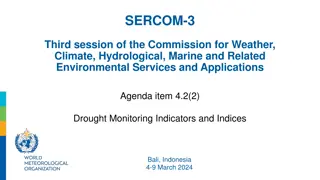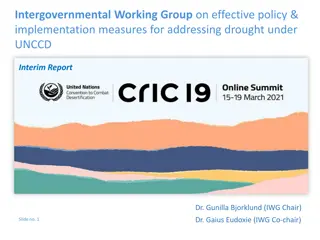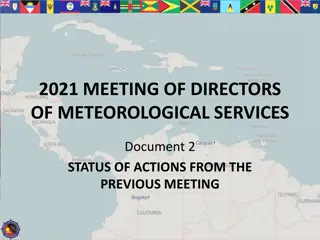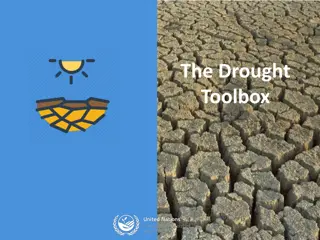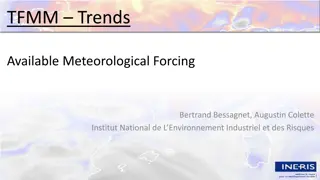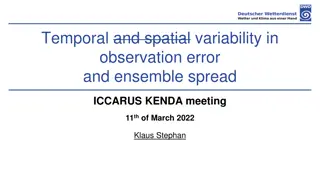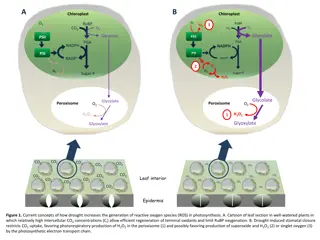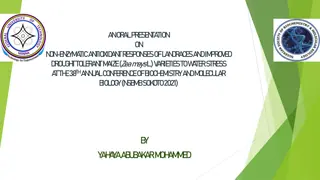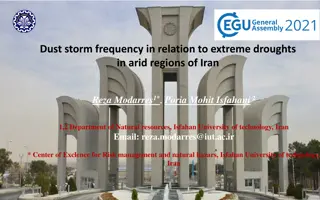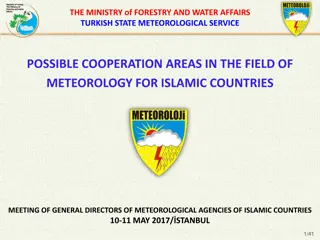Analysis of Meteorological Drought in Western Romania: A Case Study of Timisoara Area
Climate changes in Eastern Europe have led to an increase in extreme weather events like droughts in Western Romania. This article focuses on the Standardized Precipitation Index analysis of meteorological drought over the last 50 years in Timisoara. Results indicate a rise in severely dry months due to a decrease in extremely humid months. Timisoara's climate, located in the western part of Romania, is described as moderate continental with distinct seasonal variations in rainfall and temperature. The study sheds light on the evolving patterns of drought in the region based on climatological data observations.
Download Presentation

Please find below an Image/Link to download the presentation.
The content on the website is provided AS IS for your information and personal use only. It may not be sold, licensed, or shared on other websites without obtaining consent from the author.If you encounter any issues during the download, it is possible that the publisher has removed the file from their server.
You are allowed to download the files provided on this website for personal or commercial use, subject to the condition that they are used lawfully. All files are the property of their respective owners.
The content on the website is provided AS IS for your information and personal use only. It may not be sold, licensed, or shared on other websites without obtaining consent from the author.
E N D
Presentation Transcript
Reflections on Meteorological Drought Phenomenon from Western Romania Based on Station-Observed Climatological Data Rares Halbac-Cotoara-Zamfir Liviu Cadariu-Brailoiu Cristina Halbac-Cotoara-Zamfir Politehnica University of Timisoara, Romania rares.halbac-cotoara-zamfir@upt.ro
Brief introduction The climate changes from Eastern Europe led to an increased frequency of extreme weather events (such as droughts), several studies indicating that drought was severe at the beginning of the 1980s and gaining momentum again from the late 1990s onwards. In addition, it was show that Romania has experienced an increase of about 0.5 C in annual mean temperature during the last century. The records on precipitation didn t indicated any uniform long-term change although there were observed some differences along a South-North gradient
Article objectives In this article SPI (Standardized Precipitation Index) is used for a critical analysis of meteorological drought in the last 50 years (1968 - 2018) in western Romania (Timisoara area). This indices is calculated using several programs (DRINC, RDIT, CLIC- MD) recently introduced in Romanian research institutions for drought estimation and monitoring. We compared the results for SPI 3M calculated with these programs, comparison which led to the conclusion that the number of severely dry months will continue to increase as a result of a reduction in the number of extremely humid months.
The investigated area Timisoara is located in western part of Romania, being one the most important cities. The city is developed at an altitude of 90m above sea level and has the following coordinates: 45 44 58 N and 21 13 38 E. The climate is moderate continental benefiting of hot summer and mild and dry winters irregularly disturbed by periods of frost. Given the geographical position, the area covered by city of Timisoara is opened to winds for all directions, with air advections of different masses. Average annual rainfall is around 600 mm, annual rainfall being a typical continental temperate climate, with a maximum in at the end of spring (May beginning of June) and a minimum in February (see the following figures)
Figure 2 The variation of annual average temperature for Timisoara meteorological station (1968 2018) Figure 3 The variation of annual precipitation for Timisoara meteorological station (1968 2018)
In Romania there are 2 drought indices widely used: SPI (Standard precipitation index) and PDSI (Palmer drought severity index). Because SPI is an index computed by all programs considered in this article, we will use it for an analysis of drought in western Romania. SPI is a probability index that considers only rainfall and it was designed to quantify the precipitation deficit for multiple time periods. The equations underlying the calculation of the SPI index have already been widely presented in multiple articles and will not be the subject of this paper. The SPI calculation for any location is based on the long-term precipitation record for a desired period. This long-term record is fitted to a probability distribution, which is then transformed into a normal distribution so that the mean SPI for the location and desired period is zero
Results The results obtained after processing the average monthly temperatures respectively of the monthly precipitations for the period 1968 - 2018 are presented in the form of graphs (figures 4 to 12) to allow a better understanding respectively for a clearer perception of the climatic trend. In addition, we used the results to present some comparisons between the outputs of used applications (see figures 13 18) and to establish the trends of dry and humid month frequencies for different decades.
Figure 4 3M SPI index variation based on calculations provided by CLIC-MD program for 1968 - 1993 periods, Timisoara area Figure 5 3M SPI index variation based on calculations provided by CLIC-MD program for 1994 - 2018 periods, Timisoara area
Figure 6 A decadal analysis of dry and humid months weight variation according to 3M SPI index (CLIC-MD software)
Figure 7 3M SPI index variation based on calculations provided by RDIT program for 1968 - 1993 periods, Timisoara area Figure 8 3M SPI index variation based on calculations provided by RDIT program for 1994 - 2018 periods, Timisoara area
Figure 9 A decadal analysis of dry and humid months weight variation according to 3M SPI index (RDIT software)
Figure 10 3M SPI index variation based on calculations provided by DRINC program for 1968 - 1993 periods, Timisoara area Figure 11 3M SPI index variation based on calculations provided by DRINC program for 1994 - 2018 periods, Timisoara area
Figure 12 A decadal analysis of dry and humid months weight variation according to 3M SPI index (DRINC software)
Figure 13 A comparison between the values provided by 3 programs for dry and humid months weight variation according to 3M SPI index (1968 2018)
Figure 14 Comparison between the results provided by CLIC-MD, DRINC and RDIT regarding the decadal weight of the severely dry months Figure 15 Comparison between the results provided by CLIC-MD, DRINC and RDIT regarding the decadal weight of the moderately dry months
Figure 16 Comparison between the results provided by CLIC-MD, DRINC and RDIT regarding the decadal weight of the normal months Figure 17 Comparison between the results provided by CLIC-MD, DRINC and RDIT regarding the decadal weight of the moderately humid months
Figure 18 Comparison between the results provided by CLIC-MD, DRINC and RDIT regarding the decadal weight of the severely humid months All the three programs indicated 2000 as being the driest year (with 7 consecutive dry and extremely dry months from June to December) and 1970 as the most humid year (with 7 consecutive humid and extremely humid months from January to July). Other very dry years were 2002, 2004, 2007, 2009, 2011, 2012, 2013 and 2017 while recently humid years were considered to be 1999, 2005, 2010 and 2016.
Conclusions The running of the climatic data using the 3 aforementioned programs has led to similar results for the Timisoara area, the values ranges provided by these programs for the variation of the dry and humid months being short (6.06% - 9.20% for severely dry months; 8.05% - 11.84% for moderately dry months; 58.3% - 68.39% for normal months; 10.54% - 16.25% for moderately humid months; 3.78% - 5.69% for severely humid months). The statistics show us that the drought phenomenon, without having a very strict cyclical character, generally occurred at intervals of 10-15 years, more often in the recent period, the alternation of extreme drought years with excess years under the aspect of the rainfall regime (1-3 years) becoming more and more obvious. The most recent grouping of drought years is the 2000-2020 period, the drought of the summer of 2000 being considered the strongest of the last 2 decades. Analyzing the graphs of SPI 3M index variation, we can notice a climate with sharp alternations of very dry and very humid periods. However, we can also observe that severe dry months have remained at a constant level while the frequency of very humid months has decreased a lot in the last decades compared to 1968 1977 period. The use of different application for calculating drought indices can facilitate the work of the researchers in identifying different typologies of the drought phenomenon development and in anticipating the climatic variation for the next decades. However, these studies should be correlated with other measurements and analysis for reliable forecasts and conclusions.
The article was submitted for WATER (MDPI) on April 26, 2020 being currently under review process. For more info about this article/ comments/ suggestions etc. please send an email at: rares.halbac-cotoara-zamfir@upt.ro Thank You!



